Two hours away from my apartment is a merchant that sells Tamil & Telugu-language movies on dvd. Here are a few of them.
***
WHAT CAN WE GUESS THE FILM IS… JOG?
Yes?
WHY IS IT WE’RE ALWAYS TALKING ABOUT BOLLYWOOD MOVIES IN COMPARISON TO “SOUTH” FILM?
Well, you see–
I MEAN, WHAT THE FUCK DOES “SOUTH” EVEN MEAN? ISN’T MUMBAI, LIKE, GEOGRAPHICALLY SOUTH OF PARTS OF ANDHRA PRADESH? I CHECKED WIKIPEDIA.
True, yes, but Hyderabad, which is the center of Telugu-language–
AND ISN’T A WHITE AMERICAN’S CONTINUED FOCUS ON HINDI-LANGUAGE POPULAR CINEMA AS UNIQUELY (AND, GIVEN YOUR SNIDE “NEO-MASALA” LABEL, I DARESAY DELETERIOUSLY) ALTERED BY THE FINANCIAL SUCCESSES OF THE TAMIL AND TELUGU-LANGUAGE INDUSTRIES A DECONTEXTUALIZED AFFECTATION OF INDIAN-DOMESTIC ‘COSMOPOLITAN’ BIASES IN — AT BEST — THE CACK-HANDED SPIRIT OF CULTURAL TOURISM, IF NOT OVERTLY A COLONIALIST INCURSION INTO ZONES OF RESISTANCE TO GLOBALIZED SPECTACLE?
Oh no, you’ve been visiting that anarchist bookstore again. Did you steal my credit card?
YES.
Okay, listen: I agree with the words up above that happened to make sense, but –
What you see here is not the extent of the “South” industries’ popular vigor. “Neo-masala,” as I have dubbed it — which is to say, Hindi-language (Bollywood) films either remade from or heavily inspired by Tamil or Telugu-language (South) movies, in pursuit of an old-fashioned populist blend of multi-genred entertainment fronted by macho, swaggering superstar Heroes, albeit via a halfway self-aware narrative apparatus — is arguably on the wane. Or, such is the fear of Mumbai in this early May of a cashed-strapped 2013, which has seen precisely one Rs. 100 crore worldwide grosser (January’s Race 2, the latest contraption from action-suspense specialists Abbas & Mustan Burmawalla) and, more pertinently, the first bona fide fiasco of the neo-masala wave: Sajid Khan’s Himmatwala.
In retrospect, it was embarrassingly easy to root for this to happen. Khan is the brother of delightfully prickly A-list director/choreographer/actress/gadfly Farah Khan (mentioned last time), but generally lacks his sibling’s beguiling approach to oddball throwback cine-pop. Rather, he is a professional vulgarian in the Brett Ratner mold, so dismissive of the pretension inherent to ‘art’ in motion pictures that certain promotions for his latest refused to even refer to the product as a ‘movie.’ It was an “entertainer”: four syllables and two beckoning palms raised toward the critics and aesthetes who’d derided his prior trio of shrill, wildly derivative comedy blockbusters. And they were all blockbusters, successful to the point that Khan boasted Himmatwala would cross Rs. 100 crore in one week flat.
It did not make half of that in its entire theatrical run. Indeed, it just barely recouped its Rs. 40 crore production costs, which is shockingly bad for a high-profile film dropped without competition into a cherry Easter holiday weekend. Ironically, it’s not really *that* poor a film; a remake of a 1983 Hindi remake of a 1981 Telugu blockbuster, the project rather cleverly nods toward “South” influence as a cyclical thing, while swapping out some of the original’s mercy-for-the-poor thematics for a surprisingly hard-stated feminism, commenting explicitly on December’s notorious Delhi rape case, while couching issues of dowry and spousal abuse in a period context that underlines how such issues linger in contemporary India.
The problem, however, is that Khan is ultimately the sort of populist who, in denouncing the lie of ‘art,’ has neglected the value of craft; this is no longer a pure comedy, it is masala, and you do actually need a practitioner’s respect for basic cinematic values to put together engaging action scenes. So much of Himmatwala, though, is goofy and half-assed – almost defiant in its negligence toward the development of dramatic stakes on the macro and in-scene levels. No wonder the public shrugged.
***
SO, ARE YOU SAYING THE NEO-MASALA TREND IS FINISHED?
Oh god no, not as long as Salman Khan‘s around to kick the corpse. But even setting him aside, there’s signs that the trend may be developing a more trans-Indian outlook. Witness the latest from Bollywood director Apoorva Lakhia: Zanjeer/Thoofan, which has been shot once in Hindi (“Zanjeer”) and once in Telugu (“Thoofan”), with slight changes to the supporting cast in each. The Hindi title evokes one of Amitabh Bachchan’s most beloved ’70s vehicles, but the style is purely today’s:
In summary, that’s Telugu semi-star Ram Charan Teja as a hero cop who beats the shit out of the Oil Mafia when not lighting desks on fire and outrunning floods. He is joined by perpetually overcompensating Hindi glamorpuss/former Miss World Priyanka Chopra drawing an outline around her boobs, doubtlessly in formulation of an allegory for the tasks given to heroines in these types of films. Plus: Prakash Raj, rolling in like a total asshole with a SOUL PATCH and a WHITE FEDORA. When the fuck is Quentin Tarantino or Nicolas Winding Refn gonna discover this guy? Not that he needs western approval – he’s been in over 9,000 movies, cycling through the same three or four roles every time, and he’s *always* great. I’m also told the Hindi version will boast the presence of Sanjay Dutt — basically a living Frank Miller protagonist who happens to be a movie star — captured in the sweaty weeks prior to resuming a prison sentence for possession of illegal arms, so, all and all, I’d call this an “entertainer.”
***
WAIT, ARE TELUGU AUDIENCES ACTUALLY GOING TO WATCH THIS?
Eh, maybe not. Hybrid projects rarely see a lot of success; there’s some pretty sharp divisions in what audiences from different regions of India prefer to see.
I mean, what I call “neo-masala” movies in Bollywood parlance are basically just ‘really popular movies’ among Telugu audiences. And don’t think for a second that said audiences aren’t aware of the cabinets into which their films are willingly placed; sometimes, tongue-in-cheek viewer discretion warnings are issued for A-listers stepping outside their comfort zones:
Obviously there’s *some* variety among all the films that see release — just under 100 feature-length Telugu-language originals appeared in 2012 alone! — but the big-ticket items tend to hew to such a rigid action-comedy-romance-dancing formula you can watch them without subtitles and basically grasp what’s going on. It’s like attending opera. Just the other week my local Indian movie-friendly multiplex was among the 108 screens in the territorial United States to screen the spanking-new Baadshah, allegedly the most expensive Telugu production in history: Rs. 55 crore, or just over 10 million USD.
(I dunno how it got that expensive. Perhaps it was the on-location schedules in Milan and Bangkok. Or maybe it was star player N.T. Rama Rao Jr.’s lavish introductory title card, which sees his face reflected in glittering diamonds which are then fired, with some virility, out of a gleaming chrome pistol.)
Anyway, the movie was completely untranslated, and I didn’t care. You can set your watch by how routinely the songs and fights and laughs appear, with even the very mise-en-scène of director Srinu Vaitla shifting from Tony Scott by way of the CSI opening titles to a blazing front-lit ultra-color sitcom sheen to signal the switchover from one tonal track to another. I personally found myself looking forward to the musical bits, since NTR is a damn fine dancer, and — stereotypes aside — there aren’t actually very many of those in Indian pop film:
http://www.youtube.com/watch?v=YgIj7V4v90w
The film is looking to be a gigantic hit, supposedly making a run at the U.S. box office top ten on its opening night, which is a first for a Telugu picture, and… hell, possibly a first for a movie that’s straight-up not in English.
***
OKAY, THAT’S ALL VERY NICE, BUT IS SOMETHING SO SEVERELY FORMULAIC REALLY THE BEST THE “SOUTH” INDUSTRIES HAVE TO OFFER?
Oh, no no no, disembodied all-caps narrative device. Clearly, some education is necessary as to my personal favorite species of South cinema: the Batshit Insane Sci-Fi Spectacular!
Anyone will tell you that huge-budgeted Hollywood fantasy/sci-fi releases make back a good deal of their costs these days in overseas markets. It’s natural, then, to expect that bustling international film industries would produce their own like-minded pictures in response. Bollywood, however, has proven remarkably ineffective in this particular area of film production.
The first 21st century attempt to tap into this market was actually a throwback: 2003’s Koi… Mil Gaya, which recalled nothing so much as the 1980s wave of international E.T. the Extra-Terrestrial rip–offs (though, to be fair, E.T. itself drew much alleged influence from a script by Indian master Satyajit Ray). The film was a big success, though, and spawned a fantastically cheesy 2006 sequel in Krrish, a full-blown superhero(!) movie crafted in seeming homage to Mort Weisinger-era Superman stories in which the titular dickhead plays sadistic games with Lois to preserve his secret identity. This was also a big hit, and a new entry in the series is now scheduled for later this year.
Still, successful as they were, for every Krrish there were money pit losers like Drona (a calamitous attempt at a Bruckheimeresque family SFX blockbuster) and Love Story 2050 (sort of like the android bits of Wong Kar-wai’s 2046 crossed with the teddy bear parts of A.I. Artificial Intelligence, if everything was unbelievably fucking stupid). And the king of the chasm — rhetorically speaking, at least — can only be Shah Rukh Khan’s 2011 gaming culture kids’ movie-cum-vanity project gone haywire Ra.One, a 3-D bonanza I saw on an especially packed opening night, due to every first-day afternoon show having been cancelled because the 3-D post-conversion hadn’t been finished in time. By the interval, people were shouting catcalls at the screen, and every would-be dramatic moment in the second half was met with scattered laughter and disbelieving whispers.
Ra.One is nonetheless among the highest-grossing films in Bollywood history. It had to be; the ad campaign was truly excellent. It is the quintessential Blockbuster that Nobody Liked, lacking the lasting kick of renown that marks a true popular classic – to say nothing of any prayer for cultural penetration outside of India. No, for that, we must turn our attentions southward, geographically South, to Tamil Nadu: the home of a true Superstar.
***
Enthiran
Directed by Shanmugam Shankar, 2010
I trust you’ve seen this:
http://www.youtube.com/watch?v=7yBnl_krN_U
If viral recognition is the last surviving measure of success decoupled from the roaring engine of global capital, then Shivaji Rao Gaikwad, aka “Rajinikanth”… no, Superstar Rajinikanth, has brought down the thunder twice. BEHOLD:
That’s right. On the boombox: same guy.
I don’t know if it says something about Indian popular cinema’s embrace of artifice and theatricality (and the modular construction of the popular cinema itself) that the biggest worldwide video memes struck from the stuff tend to come from super-popular entertainers working their craft straightforwardly — “Benny Lava” (Prabhu Deva) is also a crazy-successful dancer, choreographer and filmmaker — but we’re definitely far enough along now online that the ‘internet popularity’ of certain Indian films can trickle into the more sealed corridors of media discussion. Enthiran, from which the crazy highway robot action two videos up was derived, for example, has been reviewed on miscellaneous pop culture sites like the AV Club, and has gradually wormed its way into the loose canon of non-English sci-fi movies you probably ought to see. For better or worse, it *is* Indian sci-fi to the outside world.
You can’t say they didn’t work for it. Weighing in with a production budget estimated at Rs. 132-150 crore (approx. 24-27.5 million USD), Enthiran is among the costliest of recent Indian films, and while official box office records are not kept for Tamil pictures, it’s generally agreed that its final grosses place it somewhere among the nation’s all-time highest earners, if not right at the top. And while all that expensive sheen doubtlessly carried its own appeal, it simply would not have have had the opportunity to exist if not for the leading man. Even more so than in Bollywood, stars matter to the South cinema, and Rajinikanth, a former itinerant laborer and bus driver, born into poverty, who clawed his way into the public eye over the course of four decades, best embodies a stouthearted set of traditional values – humble, good-humored and idealistic, he never forgets the suffering of the less fortunate.
Today he is old, bald and paunchy, and none of that matters, because the public adores him so much that any hurdle in the path of cinema illusion merely reinforces the humanity at the core of the Superstar.
Pragmatically, you could just stand Rajinikanth up and have him do his funny/brash/decent thing and build a series of mildly self-referential set pieces around him and call it a movie — that and a sprinkle of social commentary was basically the formula of director Shanmugam Shankar’s prior film, 2007’s Sivaji — but Enthiran actually does have some ambition to it. Written by Shankar with longtime collaborator Sujatha Rangarajan and lyricist-turned-dialogue-man Madhan Karky, the plot aspires to epic status, tracking the evolution of an artificial man, Chitti, from unthinking military instrument to lovesick emotional wreck to cackling weapon of mass destruction to tragic martyr, all due to the avarice of humankind. Rajinikanth plays both the robot and its creator, and while Chitti is obviously more of a show-off role, I rather preferred Rajini sir’s Dr. Vaseekaran, a somewhat morally ambiguous character who’s not entirely redeemed at the end – maybe not a *bold* character choice, but still a little out there given the reverence surrounding the Superstar.
Yet the further I get from Enthiran, the more I wonder how “out there” the writers went in composing their script. I mean – sensitive robot bred for combat? Humanity as warmongering villains? Wholesale property damage married to soggy woe-is-the-robot bathos? A narrative point of view perched somewhere amidst childish naivete, giggling self-awareness and broody philosophizing? Tone-smashing moments of slapstick humor? A weird fascination with insects, for god’s sake? Maybe my mind has been ruined by too many comic books, but it really does seem to me that Shankar & co. have drawn an awful lot of unofficial influence from another prominent force in Asian popular sci-fi: the mangaka Osamu Tezuka.
In fact, I would go so far as to declare Enthiran the single most faithful live-action depiction of Tezuka’s manga ever committed to film, despite the fact that none of Tezuka’s specific works are directly referenced. Asimov is explicitly cited, however, and the design of some of the musical interludes suggest Fritz Lang’s Metropolis by way of Daft Punk, so this could all be a rare case of different artists arriving at much the same result by way of shared inspirations. It’s beguiling nonetheless.
Still, Rajinikanth, I suspect — as with Tezuka! — carries a unique burden in embodying total popular appeal. If we are to read Enthiran as a political work, it is both sweepingly humane in the macro and socially conciliatory in the micro. It needn’t be. Sivaji, for all its routine silliness, did have one really unique and striking vignette: a spoof on India’s enthusiasm for skin lighteners, in which Rajinikanth attempts to impress a girl with multiple absurd schemes to erase his brownness, culminating in a song performed in the character of a parodic white man (with touches of, ulp, blackface):
http://www.youtube.com/watch?v=gvgI6pxzbSQ
Perhaps it was just too expensive for such jokes, but Enthiran reinforces the common wisdom at every turn. Go through the film slowly, and note the skin color of the random thugs Chitti is made to fight; the darker their skin, generally, the more obviously crude and violent they are. Heaven forbid anyone is caught wearing hip-hop gear – they might as well be clad in placards reading “MENACE.” That the songs of Enthiran are so American rap-influenced only places this strange tension into sharper relief.
And then, of course, there is poor Aishwarya Rai, another former Miss World and a Hindi movie superstar, roped into the heroine’s role presumably to guarantee the widest possible trans-Indian collections. I sound like a broken record discussing women in these movies, but Rai really is stuck with a flagrantly awful part; her love interest character is the sort of schoolgirl naif who’s clearly supposed to be a paragon of traditional virtue enrobed in a ‘naughty’ modern shell, but actually comes across as a genuine idiot, roping in an eager Chitti to help her cheat on her exams and tee-heeing herself into a hideous living caricature of every popular girl who ever friendzoned a wishy-washy Nice Guy, i.e. Chitti, the audience identification figure. She is also threatened with rape, twice, to bolster the masculine hero bona fides of each of Rajini sir’s roles individually. The more potent of the two scenarios pits the modern, cosmopolitan, intellectual Dr. Vaseekaran against a much-darker, traditionally-dressed local thug, brewing up a uniquely toxic mix of color, gender and class stereotypes served straight for public delectation.
To this, we are expected to nod and say “of course.” At a critical juncture in the film, Chitti rescues a woman from her bath in a burning building. In doing so, she is seen naked by the gathered crowd and news cameras. So great is her shame, she flees into traffic and is struck and killed by an oncoming vehicle. This is presented only as proof of Chitti’s tragic inability to grasp social nuance. No questions should be raised about the position of women in such a society. No questions about Aishwarya Rai – still playing a bubbly schoolgirl in her mid-thirties, yet very, very lucky to even be landing lead female roles at such an advanced age. She hasn’t made a film since she had a kid, and put on a bunch of weight. That is the end. Lose that shit, be Miss World, or wait until you’re old enough to play mummies and aunties. That. Is. The. End.
Of course. Of course!
***
Eega
Directed by S.S. Rajamouli, 2012
Don’t get me wrong, I *liked* Enthiran, but it’s the product of fundamentally conservative artists with one eye on the price tag; mass expectations can allow for crazy experiments in straightforward action — and storytelling deviations too, so long as they ultimately facilitate said action — but if you don’t want to piss people off you’ll still have your Superstar dancing and romancing as much as possible, without upsetting too many preconceptions. Rare is the filmmaker that can chase his bliss on his own terms, on such a scale, without the backing of a major celebrity.
Yet even in the formula-bound world of Telugu popular cinema, due just north of Tamil Nadu in supple Andhra Pradesh, there is just such an auteur: S.S. Rajamouli, director of nine feature films, every single one of which has been an enormous popular success. If money talks, it has said “trust this man” of Rajamouli, who in recent years has eschewed the star system entirely, preferring to focus his audience on the stories he tells. Remember when I mentioned above that movies like Enthiran need big stars to even exist? Rajamouli’s movies always have a star: S.S. Rajamouli. Never lacking for eager financiers, he can theoretically do anything. If he wanted, he could replace his leading man at the half-hour mark with a computer-animated insect.
And in 2012, that is exactly what he wanted.
You are correct, that is a fly dodging a bullet in Matrix-style slow motion.
Eega is startling; unforgettably so. Not because there is anything particularly outré about its storytelling — this is the kind of movie where singers on the soundtrack explicate characters’ inner emotions, so that absolutely no potential for confusion could possibly threaten the audience’s most immediate engagement with the film, a veritable zero-subtext zone — but because it is so willing to push its crowd-pleasing techniques so goddamned far over the top that, upon reflection, it emerges as less an ‘entertainer’ than a work of unbridled sadism and perversity. Starring a CG fly that dances at the end of the movie, just like in Shreck.
The first thirty minutes of the film follow the heartwarming journey of a bright, energetic young man as he ruthlessly stalks the girl of his dreams. This is *movie* stalking, though, so we’re meant to chuckle and sigh, wistfully, at his puppy-like hounding of pretty Samantha Ruth Prabhu, who, in the interest of fairness, has been alternately leading him on and rebuffing him for literally years. Nonetheless, she surely does not deserve the knotty sickness that inevitably comes from this dork showing up at her workplace and engaging in howlingly misogynistic banter with her friends:
HIM: You’d look better if you’d tie your hair up instead of letting it down.
HER: I prefer it loose.
HIM: I know you’re loose, so at least keep your hair tight!
Lol! Anyway, I lied about the knottiness, this is actually super-endearing and awesome, and useful too, since Prabhu is apt to use her would-be paramour’s omnipresence as a defensive shield against another shady dude who’s after her: a filthy-rich industrialist who’ll stop at nothing to fuck any women he fancies, and kill any man who opposes his desires. “LAVA LAVA LAVAAAA” the soundtrack purrs as he eyes Prabhu with lechery, the main differentiation between him and the virginal Hero being that the latter would presumably not act on the opportunity to sully his conquest with Filthy, Actual Sex.
Still, after just one romantic song it seems inevitable these kids will totally admit they like-like one another, until the boy is abruptly kidnapped and straight-up murdered by his zillionaire rival, the coup de grâce delivered via a bare foot slowly crushing the Hero’s windpipe. Proving that karma is always effective, however, the boy is immediately reincarnated in a nearby cluster of eggs as the soundtrack cheers “He’s back! He’s back! Life is back!”
Tethered to human memories by sheer force of devotion to his Sita, unmolested in the demon realm of Ravana, the fly sets out to do justice. Street justice.
The remaining hour and a half of Eega functions as an unofficial adaptation of the music video to Alice in Chains’ I Stay Away, with the fly doing his absolute damnedest to irritate the impulsive villain into fatally harming himself. The fly keeps him awake, tortuously, for hours on end. The fly bugs him during a shave so that his throat is cut. The fly causes the man such embarrassment that he blows a major business deal, and then the fly maneuvers him into losing all of his savings (which is to say he keeps all of his savings in a big iron safe, and the money is then lit on fire). Always, we are encouraged to cheer at each new humiliation. In the most bombastic of the film’s vignettes, the fly slides across the gelatinous surface of the man’s eyeball while he is driving, causing a fantastic highway wreck, and then the fly throws his tiny body against the dirt that has poured atop the villain’s ruined windshield, spelling out, in English, “I WILL KILL YOU.”
This is before Prabhu realizes that her non-boyfriend has been reincarnated as a fly. He spells out his identity in her fallen tears. “What should I do now?” she asks. The fly dips itself in paint and draws a straight red line on a photograph of the villain, right across his neck. “How do we kill him?” she asks.
Later, she builds the fly a tiny gas mask and wee iron claws, with which he can tear into the flesh of his adversary.
The lion’s share of credit for the non-animated success of Eega can only go to the surnameless “Sudeep,” a Karnatakan actor and filmmaker, virtually unknown to Telugu viewers, who plays the villain with a comic brio that keeps the film from registering as intolerably cruel on first impression – which, to director Rajamouli, we must remember, is the only impression that matters. Savoring every mouthful of scenery, Sudeep throws himself into madder and madder complications, at one point hiring a wizard to vanquish the fly with magic, though all the cut-rate sorcerer can manage is to bedazzle a pair of birds into a prolonged dogfight. For his troubles, the conjurer winds up gorily skewered by jagged piece of debris, while Sudeep begins to suffocate in a locked room rapidly filling with smoke, only to survive, grudgingly, to suffer again. Did I mention the computer-generated cartoon fly dances to songs at the end?
Ah, but I’m gilding the lily here. In his own way, Rajamouli is just as conservative as Shankar & Rajinikanth; instead of giving a shit about societal behaviors, he flatters his audience’s basest emotional reactions. Revenge narratives are popular all over the world, and India is no exception, with the Telugu industry particularly eager to justify images of Heroes smashing ten, fifteen, twenty men at once with the undeniable motivation of the grudge. Himmatwala had much the same plot, in fact, as did Bollywood films of the period dealing specifically with vengeful reincarnation (the groovy Karz, for instance). Rajamouli thus approaches sadism with a craftsman’s attention to detail: if the Hero is not reincarnated as a human, then how can he take revenge? How can he fight another man? Such destruction would need to be cumulative, slow. It is murder as maths.
And I should say, without hesitation, that it is proper bad-for-you fun, its set pieces well-mounted and its 134-minute run time ideal for novice sampling. It looks very nice. I was shocked to discover the picture was made for less than 5 million USD – it may not be Iron Man 3, but its blend of animation and live-action is really quite good, with any lingering cartooniness to the lead fly folded back into his anthropomorphized ‘acting.’ By its own terms, Eega is not supposed to seem entirely real or logical anyway; Rajamouli even frames his plot as a bedtime story told to a little boy, like in The Princess Bride, but with all the violence a Call of Duty kid demands in this new decade.
Obviously, the lad is too young to think about girls, or to consider the implications of a healthy young woman choosing to devote herself to a sexless relationship with an insect. Or is this Prabhu’s punishment for toying with that poor lovesick stooge? Is her karma instant? Does her film’s director identify with the hero, or the villain? Is there really much difference?
Is the jiva always desirous, in Rajamouli’s cosmos?
***
Dasavathaaram
Directed by K.S. Ravikumar, 2008
But let’s get back to Tamil Nadu. I don’t think I talk enough about those movies. Really, I don’t think I talk a lot about *most* South Asian movies — it’s not like you’d know anything about the Malayalam, Kannada, Bangla (Kolkata and Dhaka) or Punjabi film industries from this column, True Believer — but the sum total of Tamil cine-chat I’ve dished out so far consists of Rajinikanth riffs and the occasional cite to Oscar-anointed composer A.R. Rahman, and there really is quite a lot more going on than that.
Like, how could I possibly respect myself tomorrow morning without a single mention of Kamal Haasan? Oops, I mean:
That’s right, fuck you, Superstar, this is man for *all* people. Which, in South terms, means that this is purportedly a Hero for Mass and Class alike: an avowed atheist in a religious nation, a ‘method’-type actor among a congress of hams, and an egomaniac, I’d wager, disinterested in even the mild self-deprecation of a Rajinikanth baldness joke. That title card up there? It winks. Because? Of course.
Haasan’s film career dates back to the ’50s, when he was only a child, and extends to just four months ago, with Vishwaroopam, a controversial and hugely odd anti-terrorism thriller he directed and co-wrote to limited regional banning and enormous box office collections. If Rajinikanth is a Superstar, and S.S. Rajamouli a celebrity filmmaker, then Haasan is the rare personality to combine the two. He is eccentric, and whatever small visibility he enjoys in the West has been a product of eccentricity; it is said that Quentin Tarantino saw his 2001 vehicle Aalavandhan under its Hindi title of Abhay, and that one particular sequence — in which the action suddenly transforms from live-action into ’80s He-Man-caliber animation to depict a crazed murder — wound up inspiring a vastly longer and gorier stretch of the American filmmaker’s Kill Bill.
But Haasan too had a magnum opus in him, and he did not prove shy about drawing outside influence. Dasavathaaram was released in 2008, following nearly two years of production work. The director, K.S. Ravikumar, was a frequent collaborator of Haasan, though it was the leading man who devised the story and put the project into motion. Perhaps it could only have come from the pen of an actor, one madly confident enough to essay ten different roles.
Specifically: six Indian men, a Japanese guy, one Indian woman, and two American men, one of whom is United States President George W. Bush.
You can see already why this is my favorite of the Southern Sci-Fi Spectaculars detailed today, even though it is just barely ‘SF’ in the liberal sense. With a scenario prone in its first few reels to leaping across the centuries, and a leading man intent on violating racial and gender boundaries in the name of Universal Heroism, Dasavathaaram initially registers as a predecessor to Cloud Atlas as directed by Neveldine/Taylor on a Syfy original’s budget, introducing Haasan as a super-strong devotee of Vishnu who runs afoul of 12th century Hindu sectarian strife, delivering the film’s first song while elevated bloodily on hooks a la A Man Called Horse while his wife urges him to reject the specifics of his faith.
Both are subsequently reborn in the 21st century, with much irony: she is now devoutly religious, and he is an agnostic NRI scientist working on a secret American bacteriological weapons program, who suffers an acute crisis of conscience when a beloved lab monkey gets into the experimental goods and fatally erupts with the sort of garish CG effects that are just good enough to freak you out underneath your laughter. Knowing that the super-virus is too strong entrust to any governmental entity, Haasan makes a break for it, pursued by himself as the film’s primary antagonist and other main white guy: Christian Fletcher, an ex-CIA operative whom Haasan indulges with an amazing quasi-Jimmy Stewart ‘heartland’ accent, and who the makeup team may have decided to model after famous video game character Duke Nukem.
Before long, though, the film reveals itself as not so much influenced by David Mitchell as another popular art sector: the ‘everything-is-connected’ movie, stretching back to Robert Altman’s Short Cuts and Paul Thomas Anderson’s Magnolia, but typified in the 21st century by Paul Haggis’ Crash and the oeuvre of Alejandro González Iñárritu, particularly 2006’s Babel, which seems to have influenced Haasan & Ravikumar in its depiction of international miscommunication. Dasavathaaram even throws in a storyline concerning a Japanese family, although instead of brooding and sexually frustrated, they are now masters of Aikido, and prone to throwing down with any motherfuckers unwise enough to get in their way.
So, it’s sort of the Carnosaur to Iñárritu’s Jurassic Park, except with Brad Pitt as the Mexican nanny and/or Sam Neill as two or three of the dinosaurs. I can’t say that Haasan’s nonstop makeup antics aren’t distracting, but such distractions are clearly supposed to be part of the entertainment, if only to surmise whether the investigatory Japanese dude is an intentional or unintentional homage to Charlie Chan —
Or whether the Old Lady makeup was specifically meant to recall the golden age of Jim Henson’s Creature Shop.
Irregardless, Haasan does have more on his mind than latex. Two of the three extravagant hours of Dasavathaaram are set in Tamil Nadu itself, where the hapless scientist meets up with centuries-gone beloved — Asin Thottumkal, at full-throttle endearment — and finds himself stranded amidst four of Haasan’s additional personae, each of them representing a different aspect of India’s conflict-prone diversity of religion: the Old Lady, a devout Hindu and the love interest’s grandmother(!!); a cancer-ridden Sikh music star; a gigantic, childlike fair-skinned Muslim; and a dark-skinned, rabble-rousing ‘untouchable’ Dalit Christian. A fifth resident national provides comedy relief in the form of a Clouseau-like police official parodying residents of Andhra Pradesh in a manner I absolutely fucking dare anyone not living in southeastern India to even attempt to comprehend.
No, this is not a globally-minded motion picture, despite its copious English and numerous jabs at American dirty work. More so than any of the films I’ve mentioned here, it is an Indian movie intent on addressing *Indian* concerns, through mechanisms seized from the popular foreign films that play in many Indian theaters. This brand of cultural adaptation is often stereotyped as a Japanese tendency, but globalization perhaps demands it everywhere, now, in the entertainment sphere. Thus, it’s metaphorically appropriate that the most straight-on impressive bit of movie magic director Rajamouli can conjure is a climactic three-man martial arts showdown in which every participant is played by Kamal Haasan, the most fantastical of his avatars finally left so coated with karo goo on his white putty face he seems less a person than a Ray Harryhausen monster, a Superpower’s boogeyman fit only for slaying.
None of this is to say that Dasavathaaram goes down silky smooth. There’s quite a lot of tedious semi-romantic business around the two-hour mark, and Haasan’s enthusiasm for playing multiple roles doesn’t always translate to plot utility – the Muslim characters mostly seem present to declare that all Muslims are not terrorists, and the Sikh singer’s storyline seems plopped in solely to facilitate a musical number, as well as the by-far battiest denouement of the film, in which a stray bullet shoots the cancer out of the guy’s throat. We’re all connected.
But then there is a scene following a budget-busting CG depiction of the 2004 Boxing Day tsunami, killer of 18,000 Indians, which Haasan — his balls too big for even ten roles to hold — suggests was Butterfly Effected into existence by India’s ancient religious strife, providing a faux-scientific sort of rain of frogs (or a rightly Altmanesque earthquake) to temporarily obliterate the distinctions between faiths. The Old Woman, played by Haasan, embraces the dead Christian, played by Haasan, screaming at her community to stow their bigotry and leave her with the man she has come, in her senility and her sincerity, to consider her son.
It’s a grandiose, cheesy flourish, uninhibitedly sentimental and self-absorbed, but also, for a moment, earned. As Americans settle in for a long summer of mega-monied sci-fi extravaganzas, the least of them more costly than all three of these films combined, each eying as much in the way of worldwide return as possible, it is good to know that aesthetic prudence need not mark each iteration of the genre, fabulous as it nonetheless can remain.

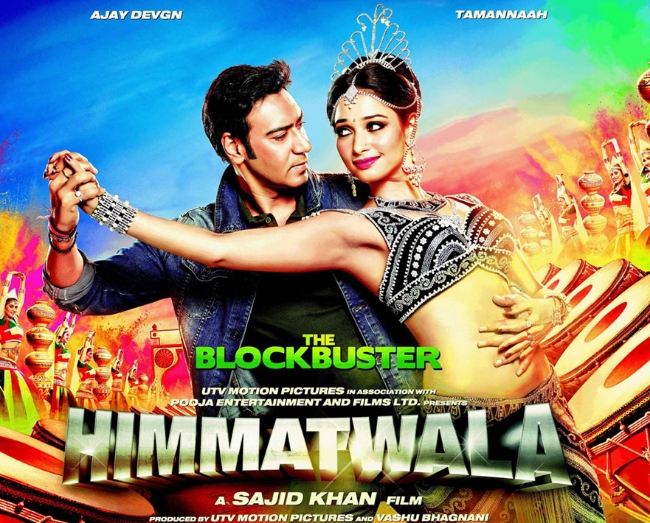
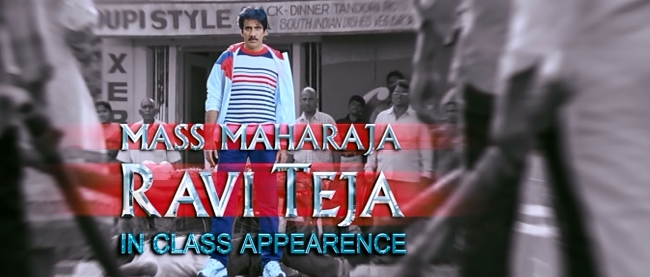
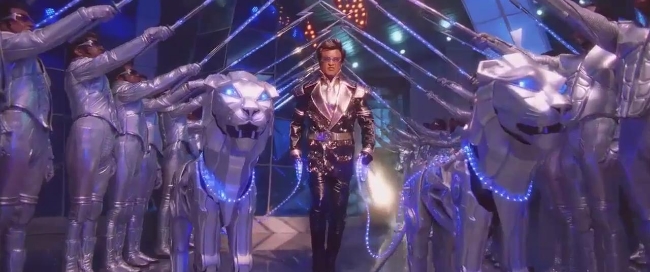



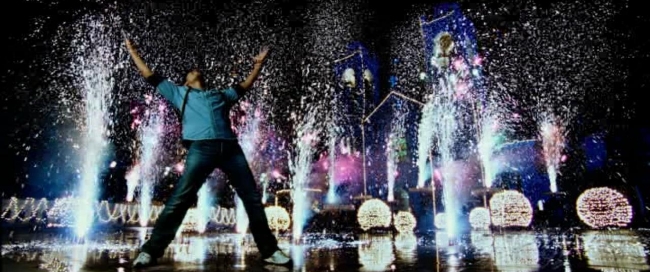
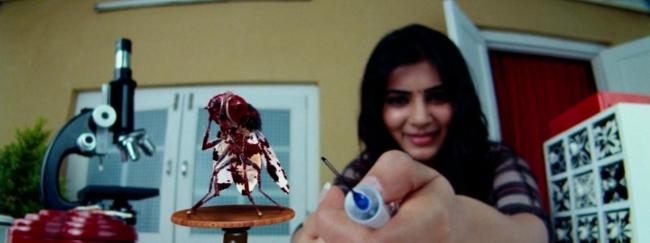


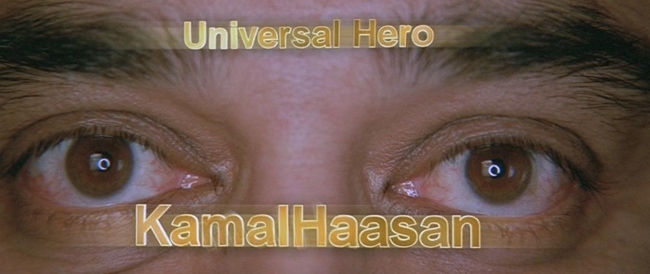
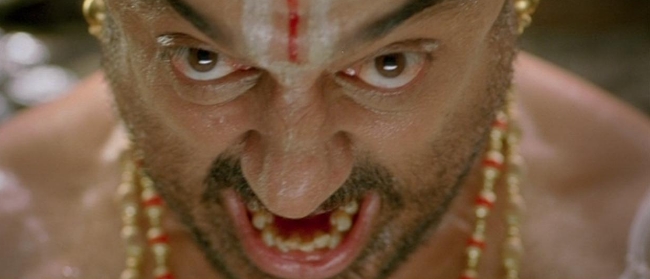
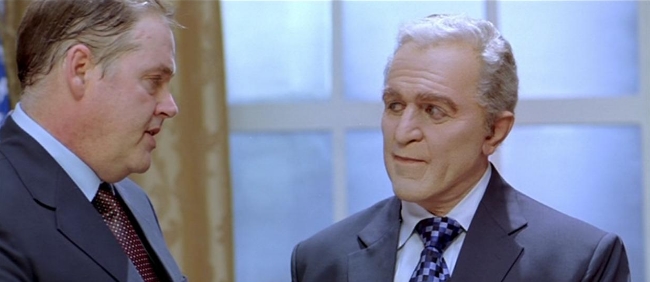
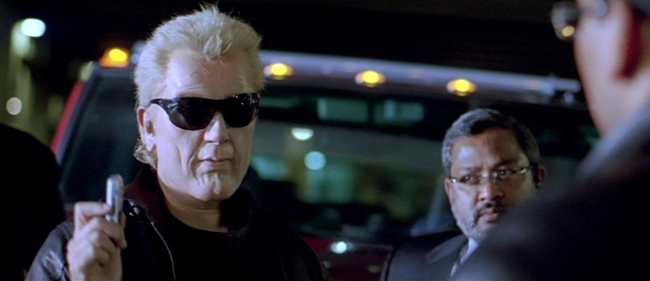
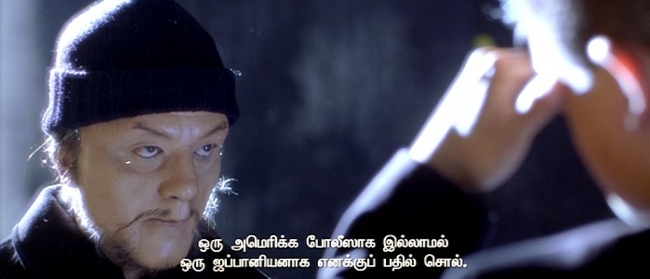
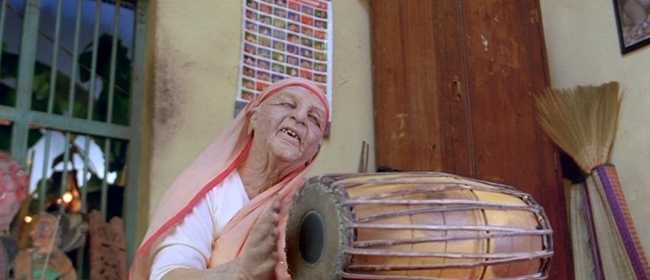
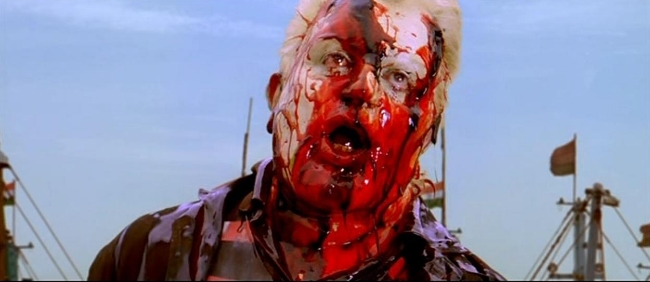
I just wanted to say that the vengeful fly is pretty hysterical. Castration fantasies and revenge narratives often go together, more or less, but I don’t think I’ve ever seen it done quite that way before.
The fly movie sounds awesome. It’s got that horror-movie, can’t escape the elaborate machinations of destiny feel, like the Final Destination movies. Except we’re supposed to enjoy the villain’s suffering because he’s a bad person, so maybe it’s more like Home Alone. It sounds like it’d be fun to watch if you didn’t think about it too hard; or if you wanted to read against the movie, you could see it as an example of how karmic theories of rebirth don’t challenge the prevailing moral order.
Dasavathaaram seems pretty cool too. Kind of like an Eddie Murphy movie crossed with Jet Li’s The One.
Also, the music in Baadshah is really good!
Thank you for writing this column, you must spend ages on these posts and I always enjoy them.
Thank *you* – I appreciate it.